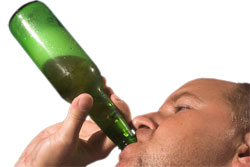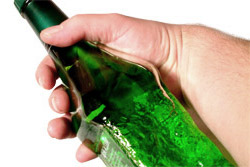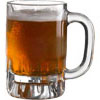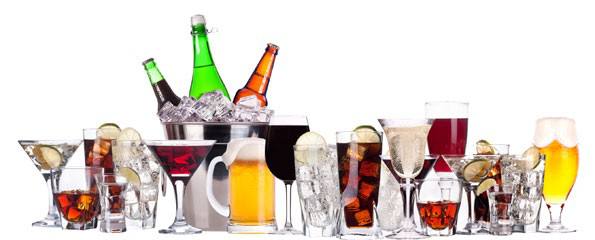Alcohol: The health, social, and financial burden
- Introduction
- The health burden of alcohol consumption
- The social burden of alcohol consumption
- The financial burden of alcohol consumption
- Interventions for negative alcohol-related consequences
Introduction
 Alcohol has played a central role in many human cultures since 4000 BC. It has even been proposed that the foundation of agriculture was not only based on food production but also on beer production!
Alcohol has played a central role in many human cultures since 4000 BC. It has even been proposed that the foundation of agriculture was not only based on food production but also on beer production!
In various cultures around the world drinking is predominantly a social activity with specific and designated spots for drinking. People drink to celebrate major events as well as everyday events, relaxation and recreation.
Various cultures may have very different attitudes, beliefs, norms and expectancies about drinking and this is reflected in the behaviours of their drinkers. In Western societies, beliefs about alcohol are inconsistent and sometimes negative and therefore alcohol is associated with problems such as anti-social and violent behaviour. In some areas in Europe and the Mediterranean drinking alcohol is considered a peaceful pastime and viewed positively – these countries tend to exhibit a much lower prevalence of alcohol-related social problems. That said, alcohol-related problems are associated with excessive drinking in any culture. In general, the majority of people consume alcohol in moderation.
Health burden of alcohol consumption
Alcohol-related incidents account for a significant proportion of overall death and disease. Globally, 3.7% of deaths (2.1 million deaths annually) and 4.4% of the total burden of disease are attributable to alcohol consumption. In Australia, alcohol is responsible for 3.3% of the total burden of disease and injury. There are marked gender differences; amongst women, 1.6% of the disease burden is attributable to alcohol compared to 4.9% of the disease burden amongst men.
Alcohol consumption is the second leading cause of preventable death and ill health in Australia. From 1992–2001, 31,000 deaths were attributed to excessive alcohol consumption. From 1993–2001 over half a million hospital stays were associated with alcohol consumption. This figure includes stays for treatment of chronic alcohol-related health conditions, but many were emergency department presentations for alcohol-related injuries. Those who consume eight standard drinks on a daily basis have a 35–40 fold increased lifetime risk of hospitalisation for an alcohol-related injury compared to individuals who drink no more than eight standard drinks a year. It is important to note that occasional binge drinking also carries a considerable risk of injury.
Alcohol-related death
Alcohol-related death is a significant public health issue in Australia. The risk of death from alcohol-related injury remains < 1% amongst men and women who never consume more than two drinks in a single sitting. Every drink above this continues to increase the risk.
Alcohol-related death amongst men
 There are significant gender differences associated with alcohol-related death. In men, the risk of death from injury is greater than the risk of death from chronic alcohol-related disease. For example, a man who consumes eight standard drinks per day has a 15 in 100 chance of dying from any alcohol-related cause in his lifetime. This includes a 5% chance of death associated with chronic alcohol-related health conditions and a 10% chance of alcohol-related injury.
There are significant gender differences associated with alcohol-related death. In men, the risk of death from injury is greater than the risk of death from chronic alcohol-related disease. For example, a man who consumes eight standard drinks per day has a 15 in 100 chance of dying from any alcohol-related cause in his lifetime. This includes a 5% chance of death associated with chronic alcohol-related health conditions and a 10% chance of alcohol-related injury.
Alcohol-related death amongst women
Women on the other hand are more likely to experience ill health leading to death from chronic alcohol-related conditions than sudden injury. A woman drinking eight standard drinks daily has a 14% chance of alcohol-related death; she has an 8.5% risk of dying from a chronic health condition and a 5.5% chance of death from an alcohol-related injury.
Alcohol-related death amongst the young
Dying whilst intoxicated is a particularly significant problem amongst young people. Amongst 14–17 year old Australians, 13% of deaths are alcohol-related. Each week a 14–17 year old Australian dies from an alcohol-related cause and a further 60 are hospitalised.
Alcohol-related death amongst Aboriginal and Torres Strait Islanders
Deaths from alcohol-related causes occur twice as frequently amongst the Aboriginal and Torres Strait Islander population compared to the non-Indigenous population. Suicide is a particularly prominent cause of alcohol-related death in this group.
Social burden of alcohol consumption
If consumed to excess, alcohol can affect all areas of a person’s life, as well as the lives of their family and friends. Personal relationships can be subjected to arguments over drinking which can lead to ongoing conflict and break ups. There are also negative consequences in the workplace arising from poor performance, accidents and absenteeism as a result of alcohol. For some, drinking in excess can lead to legal problems as a result of anti-social and violent behaviour or the loss of their driving licence.
Absenteeism and lost productivity at work
In Australia, an estimated 2.7 million lost work days annually are attributable to workers’ alcohol consumption. More than half the days lost were attributed to occasional binge drinking.
The cost of alcohol-related worker absenteeism is actually greater than this if lost productivity in the workplace is also considered. If an individual has consumed more alcohol than their body can metabolise before they begin work or school, they may still be intoxicated the following morning and performance is likely to be affected.
 | For more information about how excessive drinking can cause the symptoms of a hangover, see Hangovers. |
Reduced quality of life
Alcohol consumption is also associated with noise, violence, offensive behaviour, vandalism, petty crime and motor vehicle accidents; all of which can reduce quality of life for family members, bystanders and the community. These factors are associated with social concern and presumably their presence reduces the quality of life of the affected individuals. In addition these factors significantly contribute to the costs of welfare and policing services.
Crime
There is an association between being intoxicated and being either a perpetrator or victim of crime (e.g. robbery) in young alcohol consumers. Studies have reported that young alcohol consumers are more likely to carry weapons and engage in fights but the reason for this is unknown. There is also evidence that individuals consume alcohol in order to prepare themselves for violent encounters. The association may also be mediated by the tendency of gangs to engage in both alcohol consumption and violence.
Financial burden of alcohol consumption
 In Australia, the total direct costs that were associated with alcohol use in 2004/2005 amounted to $10.8 billion. The direct cost estimate included:
In Australia, the total direct costs that were associated with alcohol use in 2004/2005 amounted to $10.8 billion. The direct cost estimate included:
- The reduction in labour in the workforce due to decreased productivity and absenteeism ($3.6 billion);
- Premature death, sickness and unpaid labour costs (over $3.5 billion);
- Healthcare costs including medical, hospital, nursing homes, pharmaceuticals, ambulances, and road accidents ($2 billion); and
- Crime costs including costs for police, criminal courts, prisons, property damage, insurance administration and productivity of prisoners (1.4 billion).
The indirect costs for the same period amounted to nearly $4.5 billion. The indirect costs included those for loss of life, pain and suffering.
The total social cost of alcohol use in Australia in 2004 and 2005 was $15.3 billion.
Interventions for negative alcohol-related consequences
The Australian government implements alcohol intervention strategies designed to break the cycle of negative alcohol-related consequences.Culture, age and socioeconomic status will affect which alcohol intervention strategies are successful. For example, if the government starts an advertising campaign to target teenage binge drinking it would be more effective to show the immediate negative effects of binge drinking, such as car accidents, than the long term effects, such as liver failure, because this is less likely to deter a teenager from binge drinking.
There is evidence to suggest that implementing even minor interventions could significantly reduce the social burden of alcohol in Australia. Examples of these interventions include:
- Higher alcohol taxation;
- Ban on alcohol advertising;
- Lowering the acceptable blood alcohol limit for drivers;
- Greater enforcement of random breath testing; and
- Implanting greater public health strategies on the guidelines for low-risk drinking and standard drinks.
 | For more information about the mental and physical health effects of alcohol, see Alcohol and Drinking. |
References
- Social Issues Research Centre: Social and Cultural Aspects of Drinking [online]. SIRC, 2009 [cited Feb 2011]. Available from: [URL link]
- Australian Guidelines to Reduce Health Risks From Drinking Alcohol [online]. National Health and Medical Research Council; 2009. [cited 2 October 2010]. Available from: [URL Link]
- Australian drug foundation: Alcohol and its effects [online]. ADF, 2010 [cited 27 Feb 2011]. Available from: [URL link]
- Collins DJ, Lapsley HM. The avoidable costs of alcohol abuse in Australia and the potential benefits of effective policies to reduce the social costs of alcohol. Australian Government- Department of Health and Ageing: National Drug Strategy Monograph Series. 2008; 70: 1-51 [Full Text]
- Newbury-Birch D, Walker J, Avery L, et al. Impact of alcohol consumption on young people- A systematic review of published reviews [online]. Newcastle University; 2009 [cited 2 October 2010]. Available from: [URL Link]
- Links between alcohol and violence affecting young people [online]. Queensland: Department of Education and Training; 2007 [cited 2 October 2010]. Available from: [URL Link]
- Collins DJ, Lapsley HM. The costs of tobacco, alcohol and illicit drug abuse to Australian society in 2004/05. Australian Government- Department of Health and Ageing: National Drug Strategy Monograph Series. 2008; 64: 1 – 127. [Full Text]
- Poznyak V, Saraceno B, Obot IS. Breaking the vicious circle of determinants and consequences of alcohol use. Bulletin of the World Health Organization. 2005; 83(11): 801-880 [Full Text]
Dates
Tags
Created by:

 Login
Login














